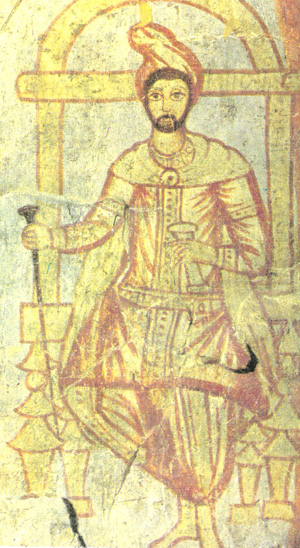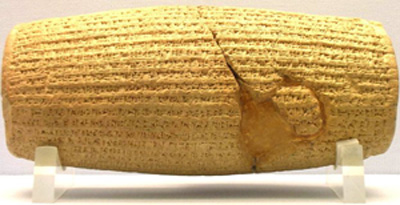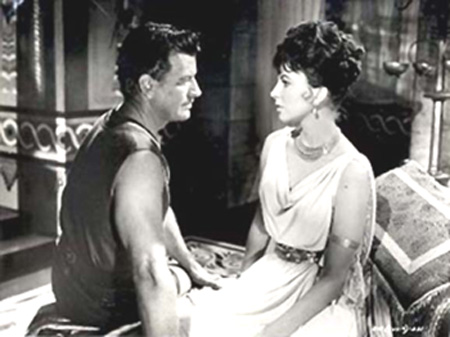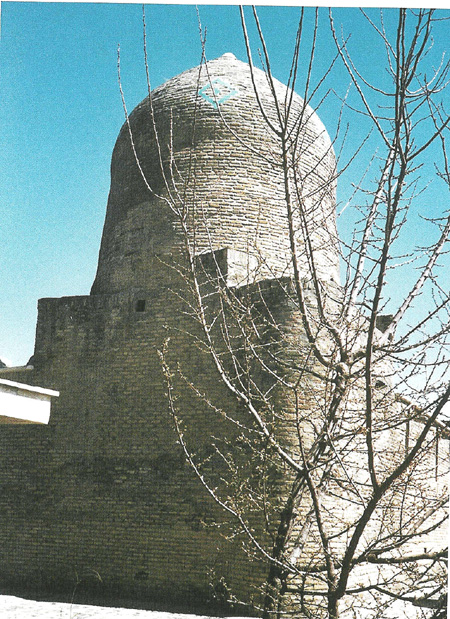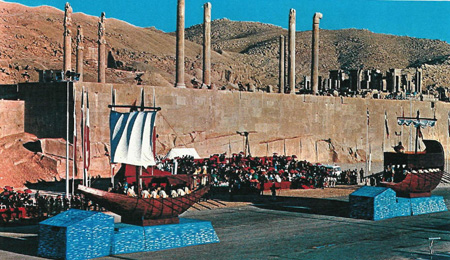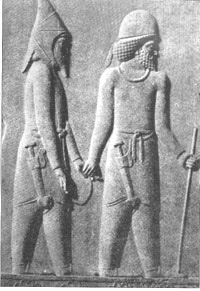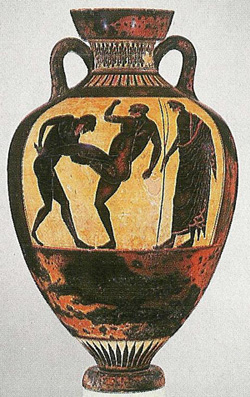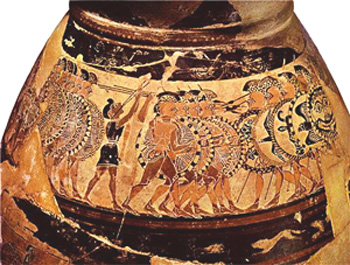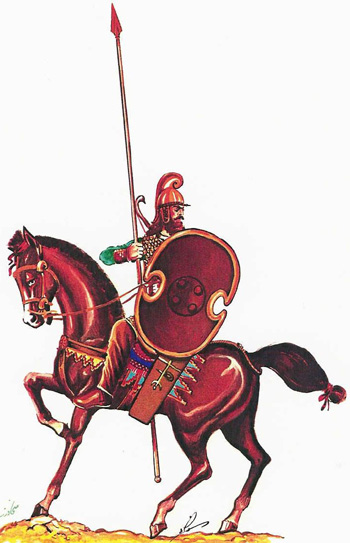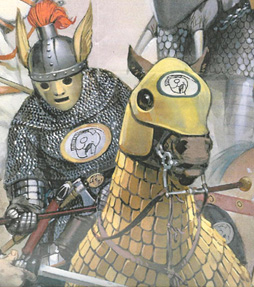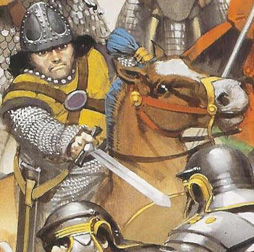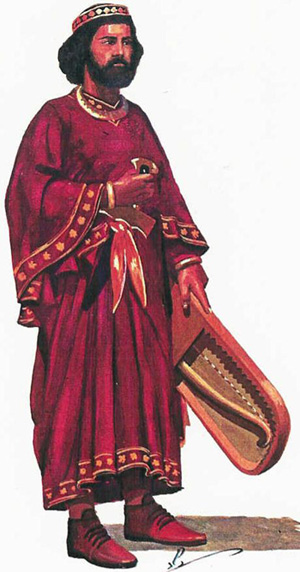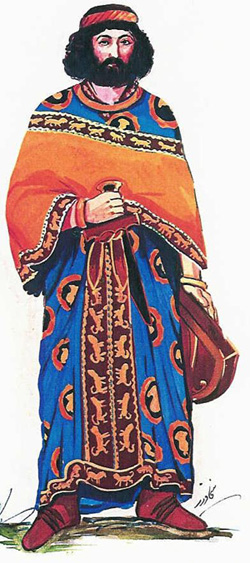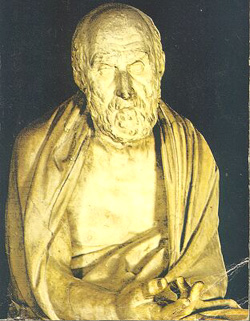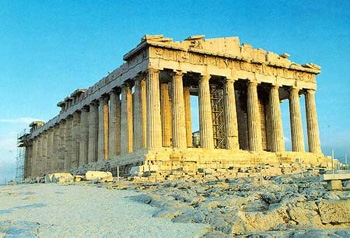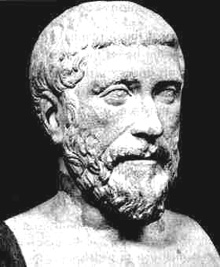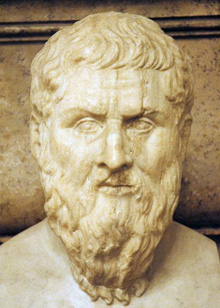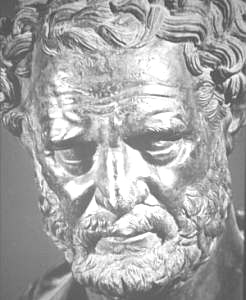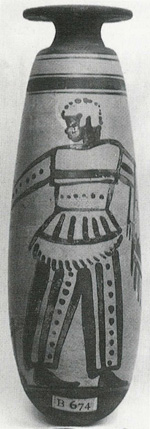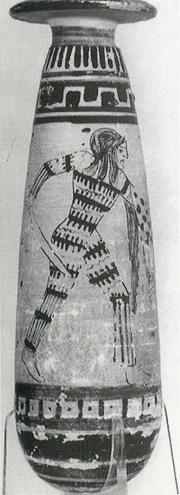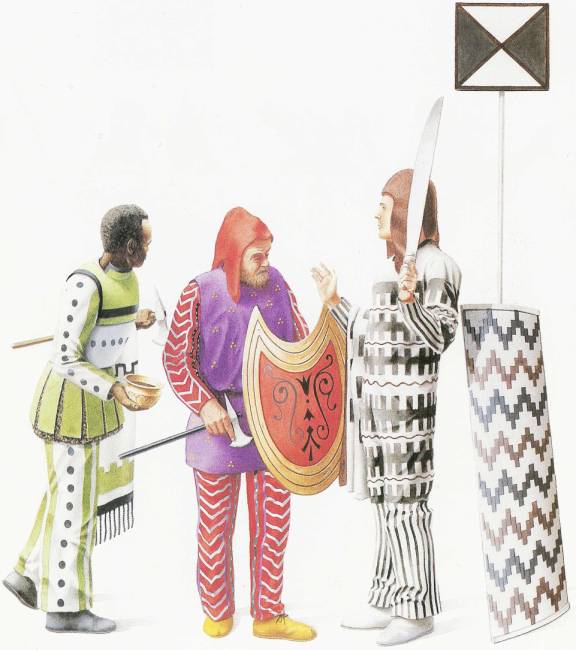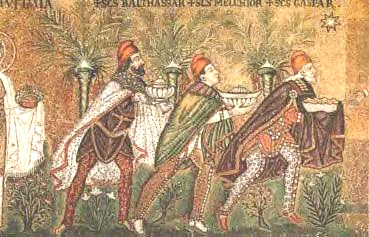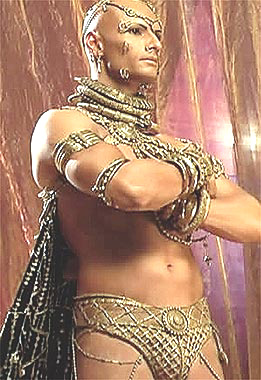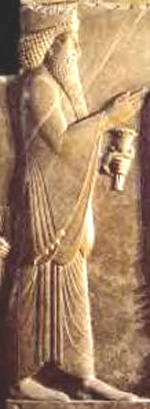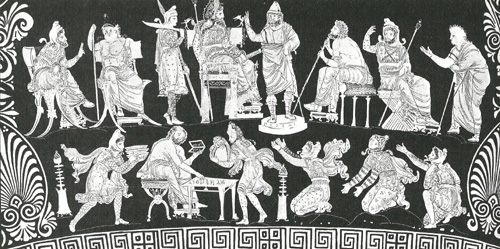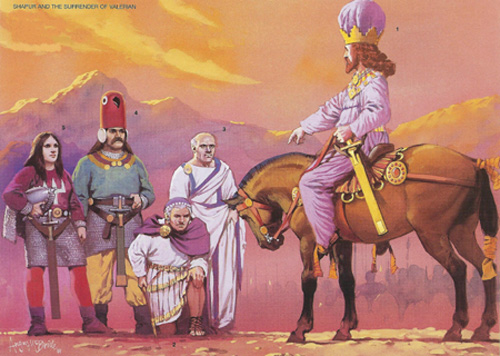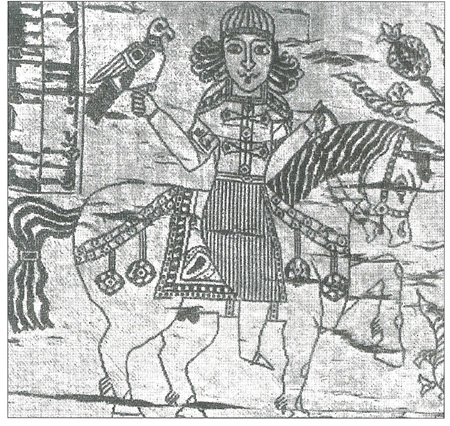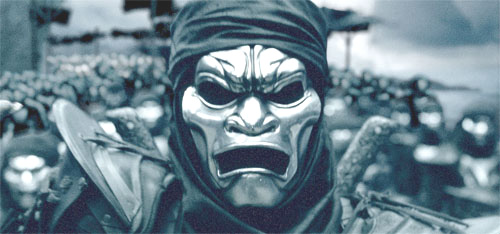|
|
||||||||||||||||||||||||||||
|
The 300 Movie: Separating Fact from Fiction Grossing
over 70 million dollars in its first week of release, the movie
“300” is set to crash into the list of highest grossing The producers of the movie (as well as the actors) are honest in stating that they did not consult primary historical sources. The writer of the comic book appears to have relied on the writings of Greek historian Herodotus, whose works, though valuable, inevitably contain an element of bias, as do any historical works from any culture. My article will not discuss the cinematography (a job best left to the film critics), nor is it a criticism of the cast and crew. There has been no agenda on the part of the original novelist, movie director, cast and crew to promote an anti-Iranian agenda. The movie however (no matter how sincerely it was intended as entertainment), is nevertheless purveying messages; messages most certainly unintended by Miller or the film producers. The
following commentary is specifically directed against the very
human biases and distortions that currently pervade against ancient
Though
perhaps trivial, I feel my background gives me a unique perspective.
Born of Iranian parents in “I watched the movie 300…and I was totally disappointed…The movie demonized the Persians, everything that was depicted in the movie about the Persians was untrue. The movie demonized also the Greeks and through some words of Leonidas Greek philosophers and Athenian civilization were downrated…I wonder why I should watch demons and Spartans with a false image…there was no showing of glorious brave and smart people from both sides. I have learned that what Spartans did in Thermopyles was magnificent, that they did not match any enemy but what they did there was really magnificent because it was achieved against a very brave, worthy and glorious enemy. …very few understand it.” In
the course of their historical intercourse, This review will focus on eight items for discussion: (1) The Notion of Democracy and Human Rights (2) What really led to War (3) The Military Conflict: Separating Fact from Fiction
(4)
The Error of Xerxes: The Burning of (5) The “West” battling against the “Mysticism” of “the East” (6) The Portrayal of Iranians and Greeks (7) A Note on the Iranian Women in Antiquity (8) “Good” versus “Evil” = = = = = = = = = = = = = = = = = = = = = = = = = = = = = = = = = = = = = = = = = = = = (1) The Notion of Democracy and Human Rights. What
struck me about the movie was its portrayal of the Greco-Persian
Wars in binary terms: the democratic, good, rational “Us” versus the tyrannical, evil and irrational,
“other” of the ever-nebulous
(if not exotic) “ “300 men stood between victory and the collapse of Western civilisation.… If the barbarian hordes…overran these defenders, Greek democracy and civilisation would fall prey to alien forces whose cruelty was a byword.” [Christopher
Hudson, “The Greatest Warriors Ever”, Daily Mail,
Note
the key words “collapse
of Western civilization”, “barbarian hordes”, “democracy
and civilisation” and “alien forces whose cruelty was a byword”. These key words are reminiscent of political
sloganeering, targeting the “other”
with slanderous propaganda. These simplistic (and patronizing)
statements are a clear indication that the general media and much
of the audience is seeing “300” as much more than just a movie
of a “graphic novel”. This has been astutely observed by Tomas
Engle, a student at a The citations from popular media outlets (such as The Daily Mail) are yet another vivid demonstration of the gross prevailing ignorance as to the actual origins of the notions of human rights, democracy and freedom, as well as the complex factors that led to the Greco-Persian wars. The origins of democracy and human rights are not as simple as we are led to believe. As we will see below, these notions share both Greek and Iranian origins. Meanwhile, the Greeks (the Athenians and their Ionian kin in particular), created the notion of “Demos” (the people) and “Kratus” (government). This government by the people is what excites the imagination of the contemporary “western world”. However, few acknowledge the role of “the East” in helping place modern democracy as we know it today, within the context of racial, religious and cultural equality, or (more succinctly), human rights. The founder of the Achaemenid Empire, Cyrus the Great, was the world’s first world emperor to openly declare and guarantee the sanctity of human rights and individual freedom.
Cyrus the Great as reconstructed by Tim Newark, 2000, p.21 (Ancient Armies, Concord Publications, painter Angus McBride) Cyrus was a follower of the teachings of Zoroaster (Zarathustra), the founder of one of the world’s oldest monotheistic religions.
Portrait of Zarathustra as depicted
in a Zoroaster
taught that good and evil resides in all members of humanity,
regardless of racial origin, ethnic membership or religious affiliation.
Each person is given the choice between good and evil – it is
up to us to choose between them. It is that goodness, and a firm
belief in its divinity, that is the key to human liberty, according
to Zoroaster. As a consequence, every individual is entitled to
liberty of thought, action and speech. This is enshrined in Zoroaster’s
guidelines: Good Thoughts (Pendar Nik),
Good
Deeds (Kerdar Nik) and Good Speech (Goftar Nik). As
a result, freedom of thought, action and speech are laden with
the awesome responsibility of wielding these for the good of all
mankind. Zoroaster taught
that there is no such thing as a “bad race” or “bad religion”.
The only divide is that between good and bad people, both within
one’s own community and those outside of one’s community.
Zoroastrians often referred to ancient Zoroaster preached the concept of an all-powerful single god known as Ahura-Mazda
(the Supreme Angel), who stood for all that is good. However,
the acceptance of Ahura-Mazda was a personal choice. There were
to be no forced conversions and the gods of all nationalities
were fully respected: Cyrus prostrated himself in front of the
statue of Babylonian god Marduk after his conquest of The
Greek warrior-historian Xenophon, spoke highly of Cyrus in
his Cyropaedia. Cyrus is described as
being void of deceit, arrogance, guile or selfishness. Cyrus is
the first “one world hero” in history, namely the ruler who sought
to unite all the peoples into one empire while according full
respect to all languages, creeds and religious practices. Alexander
the Great, who greatly admired Cyrus, adopted his mantle of the
“world hero” after his conquests of Cyrus’
system of government has been forever immortalized by the Cyrus
Cylinder. This is a clay cylinder of a decree that was issued
by Cyrus the Great in 538 BC shortly after his conquest of The Cyrus Cylinder. This is the first human rights charter in history.
A facsimile of the Cyrus Cylinder is present at the United Nations
building in New York City. There three main premises in the decrees of the Cyrus Cylinder were: (1) the institution of racial, linguistic and religious equality (2) all exiled peoples were to be allowed to return home (3) all destroyed temples were to be restored. When
Cyrus defeated King Nabonidus of
A more humane 1962
Tomb of Esther and Mordechai in
Professor
Victor Davis Hanson (Senior Fellow at the Hoover Institution,
“If critics
think that 300 reduces and simplifies the meaning of Thermopylae
into freedom versus tyranny, they should reread carefully ancient
accounts and then blame Herodotus, Plutarch, and Diodorus —
who long ago boasted that Greek freedom was on trial against
Persian autocracy…in almost all wars, one side is defending its
freedom. The Greeks were not the first human beings to defend
their freedom…monarchy is not something Eastern…when these 'freedom-defender'
Greeks were united under Alexander, they did the same thing…they
invaded Persia, Egypt and India and created their own empire…so
did their Roman successors…” [For full text see: http://www.victorhanson.com/articles/hanson101106.html] (2) What Really led to War: The Untold
Story As
noted above, Western popular opinion and academic historiography
portrays the Greco-Persian wars as being an epic contest between
liberty, as represented by Yes, indeed it is true that the Ionian revolt on the west Anatolian coast and the support of the Athenians for their Hellenic ethnic kin against the Persian Empire was a major factor that led Darius the Great (549-486 BC), the father of Xerxes, to invade Greece in 490 BC. But this is only a part of the story. Very few western historians have discussed the role of economic rivalry as a factor in the Greco-Persian wars. By
this time, the Greeks had established a powerful maritime economic
empire in the The
Achaemenid Empire became a marine empire as soon as it reached
the
Reconstruction of Achaemenid ships
in 1971. (3) The Military Conflict: Separating Fact from
Fiction There are very few historians who doubt the tenacity and military skill of the Greek defenders who faced the invading army of Xerxes. The 300 movie displayed the equipment of the Spartans relatively well, considering that the producers were intent on reproducing the images of a comic book, leaving little room for consultation with modern scholarship. If the portrayal of the Greek side was adequate, that of “the Persians” was pure fantasy. This being said, there are already a large number of viewers who have taken these images in a very “literal” and historical context – the human mind is indeed a very impressionable organ. The
discussion here is a very quick and overall analysis of the actual
military factors that were in place during Xerxes’ invasion of
Greece in 480 BC – however we will digress into the post-Alexandrian
eras, notably the evolution of the Persian knights during the
Parthian (238 BC- 224 AD) and Sassanian (224-651 AD) eras. I will
closely scrutinize the veracity of whether Xerxes actually wielded
1,700,000 troops during his invasion of Weapons. Greek spears and swords were longer than their Achaemenid counterparts. This meant that in hand to hand combat, the Spartans held the advantage and were able to “outrange” their opponents with their swords and spears, which were primarily used for thrusting (see Farrokh, Shadows in the Desert, 2007, Chapters 4-5). The swords of “the Persians” in the movie are of no historical relevance – many of the Iranian swords of that era were short and dagger-like. These were known as the “Akenakes”.
Scythian (left) and Mede (right) Saka
Tigrakhauda (Tall-capped Scythian to the left) and a Mede (round
cap to the right) appearing before the Achaemenid kings at the
Imperial For a thorough examination of the Akenakes daggers, as well as all Iranian military gear from the Bronze Age to the 19th century, consult Manoucher Moshtagh Khorasani’s comprehensive book on the subject: Arms and Armor from http://www.arms-and-armor-from-iran.de/ Armor. Greek
troops were far better armored than their opponents, although
it is not clear if all the Spartans wore heavy armor at The Martial Arts Tradition of The
300 movie did capture the camaraderie, zeal and “esprit
de corps” of the Spartans very well, and represented the contemporary
military culture of ancient As
shown in the movie, the boys of Greek warriors engaged in martial
arts “kick boxing” training – note “coach” to the right. Training
and drills were at least as brutal as combat situations. The Greek Phalanx System. The
Greeks in general had developed the phalanx system, where soldiers
fought as one unit in a single formation. Central to this system
was the use of overlapping shields which formed an impenetrable
barrier against javelins, spears and arrows. The Macedonians of northern
The Chiqi vase which shows a Greek
Phalanx (Source: www.livius.org) The Greeks often engaged in close quarter combat and had been doing so for centuries before the Achaemenid invasions. Suffice it to say that when it came to hand to hand combat, the Spartans held the advantage. Thanks to their training, the Spartans were os disciplined that they were able to collectively maneuver the phalanx at a single command. With their shields locked together, the phalanx was able to march and put forward all of their spears simultaneously. There was no breaking of formation in acts of battlefield individualism – all warriors were expected to adhere strictly and steadfastly to the phalanx. The spears protruded in deadly fashion towards the onrushing enemy, with deadly results. The Greeks testify to the bravery of the lightly armored Iranians who tried to break the spears of the Spartans with their bare hands in an endeavor to get close to the warriors within the phalanx. The Evolution of cavalry. The portrayal of “Persian cavalry” was totally wrong in the movie with respect to weapons, equestrian gear and uniforms. Superficially, these resembled more the Arab horsemen seen during the Arabo-Islamic conquests over a thousand years after the Battle of Thermopylae and bore little resemblance to either the Iranian cavalry of the Achaemenid era (559-333 BC), or the armored knights of the later Parthian and Sassanian eras of Persia (238 BC - 651 AD). Below is a reconstruction of Iranian heavy cavalry of the Achaemenid period. Mede Cavalryman of the later Achaemenid
era Despite their formidable armor, Achaemenid cavalry had yet to solve the problem of rider stability, especially against well-trained, heavily armored, lance/spear wielding infantry fighting in phalanxes (see Farrokh, Shadows in the Desert, 2007, Chapters 4-5). This is mainly because the Iranians had not yet invented saddle technology advanced enough to keep the rider stable enough as he fought on horseback. As a result, Iranian cavalry during the Achaemenid period was vulnerable to unseating by Greek heavy infantry, a fact that was duly observed by Xenophon in the early 400s BC. Nevertheless,
Iranian cavalry continued to evolve, even after the Alexandrian
conquests of the Very few are aware of the positive references to the military skill of the later Persian knights. One example is Libianus who, referring to the Sassanian knights, notes that Roman troops “prefer to suffer any fate rather than look a Persian in the face” [Libianus, XVIII , pp.205-211; Consult also Farrokh, Sassanian Elite cavalry, 2005, p.5]
The Pushtighban Heavy Knights of the Royal Guard (left) and Jyanavspar-Peshmerga (right) engaged against Roman troops during the failed invasion of Emperor Julian in 363 AD (Farrokh, Sassanian Elite Cavalry, 2005, Plate D; Paintings by Angus McBride). Much of the armor of these knights appears very “European”; the warriors wear mail, plate armor, riveted Spangenhelm helmets, broadswords, maces and battle-axes. Yet these warriors predate their European counterparts by centuries (see Farrokh, Sassanian Elite Cavalry, 2005). Though
the Spartans (and indeed the Greeks as a whole) are rightfully
remembered as magnificent warriors whose exploits and heroism
resonate across time, This
bias is not confined to the entertainment media. The academic
community (mainly in northwest European and English-speaking world)
has until recently continued to champion ancient Professor John Keegan Keegan’s
interpretation is essentially rejected by a large number of historians
such as Herrmann, Michalak, Inostrancev, Nickel and “…there is no need for academics to
denigrate The Immortal Units. Perhaps most interesting was the portrayal of the Immortal units of the Achaemenids. Superficially, they resembled Hollywood-style “ninjas”, dressed in black. Black and dark clothing were not featured among any of the standard Achaemenid troops. The superficially “Oriental” looking iron face masks were never used by the elite troops, and as noted above, Iranian units (in general) were more lightly armed and armored than their Greek counterparts. The paintings below provide a more accurate reconstruction of the uniforms, weapons and armor of the Achaemenid troops. Achemenid Persian officers as they would have appeared during Xerxes’
invasion of These were reconstructed by historians, researchers as well as professional army officers in 1971. Suffice it so say, that the movie portrayal and historical veracity are widely divergent. Note the colors on the uniforms as well as the equipment (and virtually no armor). But at least the creators of the 300 picture admit that they are basing their “Persians” on cartoon-like demon characters. The
Size of Xerxes’ Invasion Force. Few question the fact that Xerxes’ army was huge and that the Greeks were outnumbered. The question is “by how much”? The trailer of the movie states: “They [the Spartans] were 300 men against a Million”. The main source of these accounts for modern European scholarship is Herodotus, who actually cites 1,700,000 invaders (Herodotus, VII, 60). Herodotus, who wrote after the Greco-Persian wars of Darius and Xerxes had ended, and before the age of Alexander.
Herodotus (484-425 BC) Herodotus
lists a total of 46 nations mustered by Xerxes in his invasion
of Nevertheless, it is unfair to pin these quantitative citations solely on Herodotus. The Greek tragedy by Aeschylos, The Persians, describes the Greeks facing Xerxes’ armies as facing "a great flood of humans…a wave of the sea that cannot be contained by the most solid dikes (The Persians, lines 87-90)…” and ”…a rash ruler of populous Asia [Xerxes] pushes a human herd to the conquest of the entire world" (The Persians, 73-75). It was from the mid-19th to the early 20th centuries when a number of European scholars began to question the fantastic numbers cited by Herodotus. European researchers such as Gobineau and Delbrueck began to seriously doubt the numerical claims made by Classical sources. The table below cites some of the researchers of the period who provided the following estimates as to the actual size of Xerxes’ invading armies:
Most
modern scholarship appears to accept the figure of 100,000-200,000
invading troops, a figure consistent with the population base
of the Achaemenid Persian Empire at the time (Farrokh, Shadows
in the Desert, 2007, Chapter 5). Even
if the At
Few
have addressed the engineering feats that Xerxes’ engineers accomplished
in building the world’s first true bridge between “Engineering an Empire: The Persians” http://store.aetv.com/html/product/index.jhtml?id=77071 The
show is also available in 5 parts on youtube – part 4 narrates
the engineering aspect of Xerxes’ invasion of
A Final Note: The There
are other inaccuracies in the movie as well, especially with regards
to the Greek perspective. First, the Spartans were not exactly
“democratic” in the Athenian sense; theirs was a hierarchical
and militaristic society. To argue that the Spartans were “fighting
for Democracy” is somewhat simplistic. It is correct however that
the Spartans fought for the glory of Second,
the 300 Spartans were not alone in their last stand – they were
accompanied to the death by at least 300 Thessapian Hoplites,
who fought shoulder to shoulder beside them. The fact is that Xerxes finally won at Typical
of the drama of Greek politics, Themistocles, the man who had
rescued (4) The Error of Xerxes: the Burning of The
greatest blunder committed by Xerxes in his invasion of
The Acropolis in Xerxes’
troops destroyed many towns, villages, farms and temples. These
actions stiffened the Greek determination to resist and expel
the invader from their soil. As I have previously noted, the statues of sacred
Greek gods were confiscated and bought to Xerxes
soon realized the error of his actions, but it was too late. His
offers to rebuild (5) The “West”
battling against the “Mysticism” of “the East” Towards
the end of the movie, there is a statement to the effect that
the war is against “the Mysticism and Tyranny” of Few
would question the fact that the Greeks pioneered much of what
we cherish today with respect to logic and philosophy: Greeks
(like all great peoples of history) are integral to world civilization.
But any type of assumption that ALL of learning has been historically
confined to While
outside the scope of this discussion, it may surprise some readers
to know that a number of the greatest Greek minds of the Classical
era, Pythagoras, Plato, Thales, and Democritus,
traveled to the Persian Empire to take advantage of the centers
in learning in Persis, Babylon and Egypt, notably in the fields
of astronomy, mathematics, physical sciences, geometry and theosophy
(see Farrokh, Shadows
in the Desert, 2007, Chapter 4).
The
Greeks, like many other of the learned and civilized peoples of
antiquity, also had their share of superstitions as well.
Very few are aware that the study of Astronomy was
actually prohibited in ancient The
evolution of learning very much resembles the evolution of human
rights in history: it is organic and is ultimately achieved by
the synthesis and sharing of ideas between nations, cultures and
peoples, whether they are engaged in trade, cultural relations
or war. For
further references consult the reference list of discussion item
(1). (6) The Portrayal of Iranians and Greeks What struck me most vividly in this movie was the following question: Where
are the Greek actors in this movie? After all, is this movie not
narrating a story about ancient The straight forward answer would be that the movie producers were depicting the characters of a graphic novel, which may explain their casting decisions. There still remains the question however of why not at least consider utilizing Greek actors to portray Greek historical characters? The Alexander Movie: How are Greeks and Iranians Portrayed? http://www.ghandchi.com/iranscope/Anthology/KavehFarrokh/farrokh6.htm When
it comes to the portrayal of the Iranians and the Greeks, I find
the following observation by Dr. Ahmad Sadri (College Professor of Islamic World Studies, “Snyder’s Persians – I am not talking about the disposable extras covered up to their eyes in male burqas – are predominantly black and by implication of mannerism and affect, homosexual. Allowing the widest berth for the genre and medium one still marvels at Snyder’s audacity in demonizing the “Asiatic hordes” while morphing the Spartan warrior into the typical white American survivalist. Snyder’s Spartans are white guys fighting a sea of racially inferior blacks, yellows and browns. ” As I walked out of the theater during the closing credits, I heard the following comment by one of the viewers in the audience: “This movie chose really excellent Eye-ranian [Iranian] actors – they showed them so accurately – just what you would expect them to be…” It
is very interesting that in this movie (and its comic book original)
insists on portraying the “Persians” (especially the elites) as
black Africans. In the movie trailer, King Leonidas is shown kicking
the “Persian messenger” into a bottomless pit and shouting “This
is http://www.youtube.com/watch?v=bCwT0TF6fa4 Movie Trailer for 300 The “Persian messenger” is black. Other Persians in the film are also black, including a “Persian” general executed by Xerxes and a “Persian” emissary sent to communicate with Leonidas – the latter role being played by talented actor Tyrone Benskin (Marked Man, 1996; Sci-Fighters, 1996, etc.):
Tyrone Benskin Interestingly,
the recent movie, Alexander (starring Colin Farrell), featured
(with few exceptions) Arabic speaking North Africans instead of
Iranians in the role of “the Persians”, whereas the 300 book and movie portrays Iranians as Africans. As we shall see later below, there are indications
that There are NO Greek or Roman references to black “Persians” and Greco-Roman sources also CLEARLY distinguish between the Arabs of antiquity and “the Persians.” Greek vase art from the Classical period show “the Persians” as remarkably similar to the Greeks – their differences are in wardrobe and equipment: In this discussion, I will make use of the term “Iranian” as opposed to “Persian” as the former is more inclusive and includes Kurds, Azeris, Persians and other peoples of Iranic origin. The term “Persian” was used by the Greeks to designate all Iranian peoples of the time, when in fact, the Medes and the Scythians (Saka) were also partners in empire alongside the Persians. There
is a dearth of primary sources to help archeologists, anthropologists
and historians reconstruct the ancient Iranians contemporary to
Xerxes’ invasion of
African levy in Achaemenid service (left) and Iranian troops (right) as portrayed in Greek art. The Greeks clearly distinguished between the Iranians (portrayed as Caucasians) and Africans in their artistic works (Nick Sekunda, The Persian Army, Osprey Publishing, 1992, p.16-17). As a Classical historian, Sekunda has reconstructed King Xerxes, Iranian warriors as well as their African contingents:
Ethiopian marine (left), Iranian
warrior (centre) and Iranian spearbearer (Nick Sekunda,
The Persian Army, Osprey Publications,
1992, Plate C; Paintings by Simon Chew).
Note
how these re-constructions differ from how Iranians have been
portrayed in the “Alexander” and “300” movies. The
Iranians shown in the centre and right would not look unusual
in today’s Roman depiction of Iranian nobles
depicted here as the three wise men. It is clear that the Romans
were objective in their portrayal of their enemies, the Parthians
and the Sassanians. The
cultural and linguistic legacy of the Indo-European or “Aryan”
arrivals on the Iranian plateau since at least the 2nd
millennium BC continues to resonate in modern However
what makes Genetic
researchers have conducted a number of detailed genetic studies
on Put simply, the results show a very high incidence of U5 lineages – genes common among modern
Europeans as a whole.
The results are aptly summarized as such: “…many Armenian and Azeri types are derived from European and northern
Caucasian types (p.1263)…The U5 cluster… in Europe… although
rare elsewhere in the Near east, are especially concentrated in
the Kurds, Armenians and Azeris…a hint of partial European
ancestry for these populations – not entirely unexpected on
historical and linguistic grounds (p.1264)” [Richards et al., (2000). Tracing European founder lineages in the Near
Eastern mtDNA pool. American Journal of Human Genetics,
67, p.1263-1264, 2000] There were no genetic links between the Iranian
groups cited and the Arabs of that study. Interestingly, a number
of Turks from western
Photograph taken in 1971 by Ali Massoudi of a girl from There seems to be very little international motivation to understand the multifaceted nature of the Iranians themselves as well as their history and culture. A survey by Jack Shaheen (author of “The TV Arab”, 1984) in the early 1980s found that over 80 percent of North Americans wrongly believe Iranians to be Arabs and to speak Arabic. This may explain in part the persistence of the “Hollywood Persian” image in the entertainment industry. Addendum:
Is there a Case of Institutionalized Discrimination against Iranians
in There
are disturbing indications that a subtle form of racism has at
times been applied in
A
portion of the filming took place in Many
of the “Iranians” who showed up on the set proved to be a major
disappointment to Norris. This is because, far from fitting into
the popularized “Hollywood Persian” stereotype, the potential
Iranian extras displayed a variety of phenotypes. The group included
Iranians from the northern regions (Gilan, Mazandaran, Semnan,
Talesh), the northwest ( “…the directors came to the set
and were upset to see us. Among us were Mashadis of Turcomen background
[with Central Asian/Far eastern appearance], Baluchis and more
blondish types from the north and west…Norris and the directors
said ‘what are these Caucasians doing on the set? I said I want
‘Iranian extras’ not Caucasians…Americans like to see real Iranians…” The
recruiters then explained that the “Caucasian” extras were natives
of
If the portrayal “the Persians” is fictional, that of Xerxes has set new parameters for creativity. For a thorough analysis of the actual appearance of Xerxes, kindly consult Daniel Pourkesali’s article: Movie 300: A Tale of Pure Fantasy http://www.payvand.com/news/07/mar/1157.html As
noted astutely by Daniel Pourkesali, the movie’s portrayal of
Xerxes is based faithfully on the graphic novel, but widely divergent
with historical depictions of Xerxes. Below is his portrait as
he appears in An Iranian portrait of Xerxes Below
is another reconstruction by Professor Sekunda of Xerxes as he
would have appeared in Court Eunuch (left), King Xerxes (centre) and Royal Spearbearer (right) (Nick Sekunda, The Persian Army, Osprey Publications, 1992, Plate B; Paintings by Simon Chew). Below is a Classical Greek depiction of Xerxes when he was still a prince in the court of his father, Darius the Great:
Greek depiction of Darius the Great
(seated on throne in top row at centre) debating with his advisors
as to whether he should invade The
Miller/Warner Brothers portrayal of Xerxes and the way he would
have historically appeared are literally as different as day and
night. Professor Ephraim Lytle, a Hellenistic
historian at the “300's Persians are ahistorical monsters and freaks. Xerxes is eight feet tall, clad chiefly in body piercings and garishly made up, but not disfigured. No need – it is strongly implied Xerxes is homosexual which, in the moral universe of 300, qualifies him for special freakhood.” [Professor Ephraim Lytle, “ (7) A Note on the Iranian Women in Antiquity I
received the following e-mail from “Pedram” which aptly summarizes
this segment of our discussion: "Have you seen the movie? I have heard that
it was so insulting to Persian women… " The
300 movie certainly portrayed Iranian women as shallow, mindless
“harem girl-objects”. This is even testified to in the trailer: http://www.youtube.com/watch?v=bCwT0TF6fa4 The
portrayal of Iranian women in this movie is not only grossly inaccurate
in historical terms, but also degrading, insulting to women in
general. Again, this seems to be derived from a massive sense
of ignorance regarding the role of Iranian women in history. The
women of ancient Roman
sources are very clear in referring to women among the ranks of
the Iranian cavalry in the Sassanian era: “in the Persian army…there are said to have been found
women also, dressed and armed like men…” [Zonaras (XII, 23, 595, 7-596, 9)
in reference to forces of Shapur I]
King
Shapur receives the surrender of Emperor Valerian at Barbalissos.
Female Iranian cavalry officer (left), nobleman of the Suren clan
(with tall “beaked” hat), Emperor Valerian (kneeling), Roman Senator
(man with toga) and King Shapur I (right) (Farrokh, Elite
Sassanian Cavalry, 2005, Plate A; Paintings by Angus McBride). Iranian
women organized resistance against the Arabian invaders of the
Ummayad and later Abbassid caliphates after the fall of Sassanian
Iranian
women continued to play leadership roles well after the fall of
Sassanian
Governess
of Rayy (Farrokh, Elite
Sassanian cavalry, 2005, p.60) The
equality of women with men in enshrined in the Zoroastrian religion
itself. One the Zoroastrian fables refers to a conversation between
Zoroaster and his daughter Freyne highlighting the fact that it
is up to women to choose their mates for courtship and marriage. (8) “Good” versus “Evil” A short and final point has to do with the portrayal of “the Persians” as “evil”. In one of the earlier scenes, King Leonidas holds a dying boy who, in reference to the invading host, states softly that the Persians “…came from the blackness…”. It is very clear that “the Persians” are literally portrayed as “evil”.
The retort to this is that the movie is only faithfully reproducing the characters of a harmless comic book. But is it? How
would members of other ethnic communities worldwide feel if their
ancestors were being portrayed as monsters, troglodytes, degenerates,
and demons? These same producers would probably think twice if
they were to portray other nationalities in the manner that they
have done with the “Persians”. If my logic (flawed as it may be)
is not mistaken, portraying Iranians as monsters, troglodytes,
degenerates, and demons is “artistic entertainment”, but other
nationalities are exempt from this “art form” as this would be
“tasteless and politically incorrect” and would be regarded as
a “hate crime”. The
targeting of specific ethnic groups with negative attributes in
the name of entertainment dollars is dangerously misinformed and
irresponsible. As noted
earlier in this commentary, viewers and media outlets (especially
in the English-speaking world) are already interpreting much of
the movie in a “historical” light.
The Greco-Persian wars evoke very intense emotions in northwest
European culture, in some ways even more so than in modern-day
It is at this juncture of the discussion, where we must remind ourselves of one of Zoroaster’s chief teachings: Zoroaster taught that good and evil resides in all members of humanity, regardless of racial origin, ethnic membership or religious affiliation. Each person is given the choice between good and evil – it is up to us to choose between them. = = = = = = = = = = = = = = = = = = = = = = = = = = = = = = = = = = = = = = = = = = = = Having
discussed the issues at length, it is hoped that the reader will
appreciate the multifaceted and organic nature of human history.
Nations, peoples and cultures have had a symbiotic relationship
with one another through trade, cultural exchanges and war. It
is these very processes that have shaped our identities and who
we perceive ourselves to be today. As the size of our world diminishes
daily due to the breathtaking leaps in technology and communications,
it is all the more important to make the endeavor to understand
history, not in terms of “east” versus “west”, but with the appreciation
of human civilization being a collective. Regards Kaveh Farrokh = = = = = = = = = = = = = = = = = = = = = = = = = = = = = = = = = = = = = = = = = = = = Dr.
Kaveh Farrokh is the author of “Sassanian
Cavalry” (Osprey Publishing, 2005). He has lectured at the
http://www.ospreypublishing.com/title_detail.php/title=T1087 Notions
of Democracy and Human Rights/What Really Led to War Abbott, J. (1902). Cyrus the Great.
|

